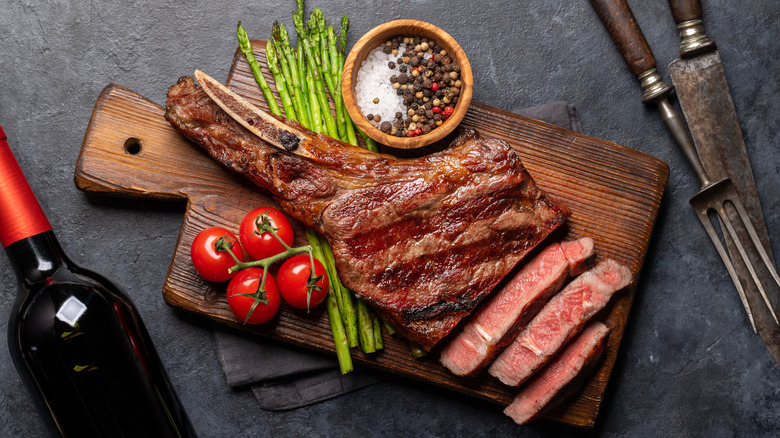Tomahawk Steak Over Charred? Here's What Might Have Gone Wrong
Few dishes garner the same level of praise and admiration as a perfectly grilled steak, even more so if you're using an impressive, flashy cut like tomahawk — the bone-in version of a rib-eye. But that perfect charred crust on the outside paired with the blushing pink, medium-rare interior is deceptively tricky to achieve, making it all the more impressive and delicious, so it's no surprise that this was one of Anthony Bourdain's favorite styles of steak. To find out how to avoid over-charring your tomahawk steak for guaranteed perfect results next time, Food Republic spoke with Chef Brett Reichler of the legendary Gallaghers Steakhouse of NYC.
"A tomahawk is a very thick cut, so if you go straight to high heat, the outside will char too quickly and form a kind of shell," Reichler told us. "The outside gets dark and crusty, and that char actually insulates the meat." Starting at high heat will create a variety of challenges: Cook your tomahawk too short and too hot, the Maillard reaction — when amino acids and sugars are exposed to high heat — will form a bitter, burnt crust while the interior comes out undercooked. But leave it on too long and protein coagulation will cause the muscle fibers to tighten and squeeze out moisture, leaving your steak dry and tough — and still burnt!
To prevent a burnt exterior and an undercooked interior, Reichler instead recommended cooking a tomahawk low and slow. "Start on the cooler part of the grill and rotate often between the wide surfaces and thinner edges," he explained. "This allows the internal temperature to come up gradually without overcooking [or] oversearing the exterior."
More tips for a perfect tomahawk
Evenly cooking thinner cuts of steak is much easier than thicker ones. By the time the crust forms for thinner cuts, the steak should already be evenly cooked, whereas for thicker cuts, like a tomahawk, you have to be mindful of perfecting the timing between a perfect crust and interior doneness. According to Chef Brett Reichler, one tip for a perfectly cooked steak involves switching things up a bit — and using the infamous "reverse sear" method. Any thick cut is the perfect steak for a reverse sear.
To do this, "wrap the steak in foil while it comes up to temp so it doesn't over-char," Reichler told us. "Once it's close to where you want it, remove the foil and finish it directly over higher heat to get that nice crisp golden crust." This ensures that the steak is already cooked to perfection before it develops the insulating crust. Alternatively, you could take a tip from our steak-cooking guide, and after a brief pan-sear, put your tomahawk in the oven to let it finish cooking without burning.
To guarantee your steak has reached that perfect level of doneness, Reichler said you're also going to need a meat thermometer. This is a pantry-essential and can provide much-needed peace of mind to those who worry about doneness. "For medium-rare, pull the steak at about 120 to 125 [degrees Fahrenheit]," Reichler recommended. "It will continue to rise a few degrees while resting," which is a process known as carryover cooking. Remember, let your tomahawk rest for up to 15 minutes after cooking to allow the muscle fibers to relax and the juices to redistribute.


